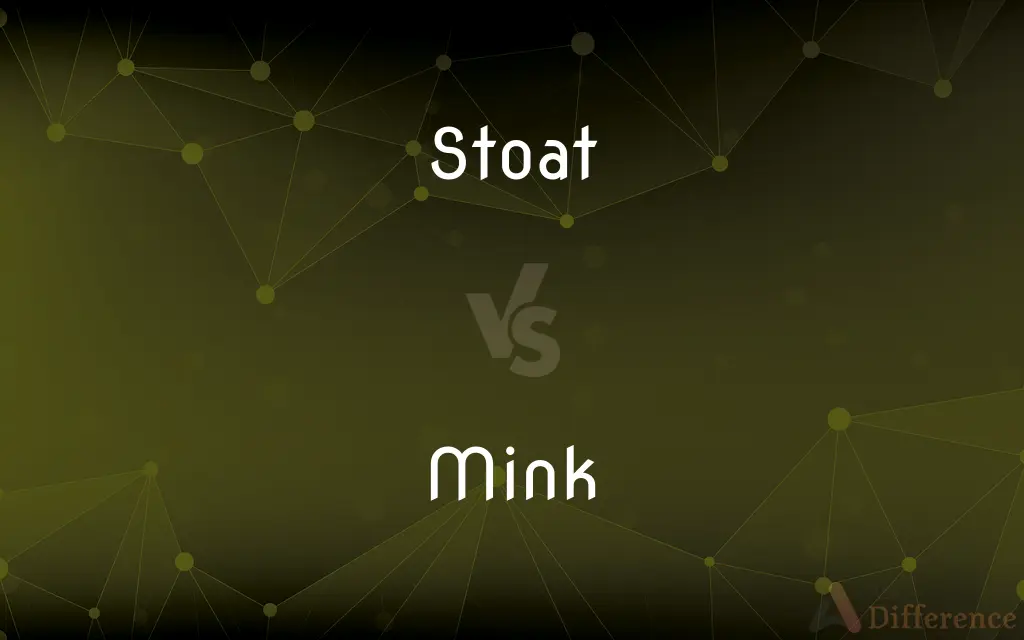Stoat vs. Mink — What's the Difference?
By Tayyaba Rehman & Maham Liaqat — Updated on April 2, 2024
A stoat is a small, agile predator known for its winter white coat, while a mink is larger, semi-aquatic, and prized for its fur.

Difference Between Stoat and Mink
Table of Contents
ADVERTISEMENT
Key Differences
Stoats are known for their distinctive seasonal color change, sporting a white coat in winter to blend with snowy environments. Whereas minks maintain a consistent dark brown fur throughout the year, making them less visible in winter landscapes.
Stoats, being smaller, prey primarily on rodents and rabbits, using their agility to chase down prey in open fields and burrows. On the other hand, minks have a more diverse diet, including fish, birds, and mammals, thanks to their semi-aquatic nature which allows them access to a variety of habitats.
The habitat of a stoat typically includes fields, woodlands, and farmlands, where they can find shelter and prey. Minks, however, are often found near water bodies like rivers, lakes, and marshes, utilizing their swimming abilities to hunt.
Stoats have a unique hunting technique, performing a 'dance' that mesmerizes their prey, allowing them to get closer before striking. Whereas minks rely on their swimming speed and agility to catch prey, often diving underwater to pursue fish or waterfowl.
Reproduction differs significantly between the two; stoats have a delayed implantation, meaning the fertilized egg does not immediately implant in the uterus, allowing for a flexible birth schedule. Minks, in contrast, do not have this adaptation and have a more straightforward reproductive cycle.
ADVERTISEMENT
Comparison Chart
Size
Smaller, with a body length up to 30 cm
Larger, can reach up to 45 cm in body length
Habitat
Fields, woodlands, farmlands
Near water bodies like rivers, lakes, marshes
Diet
Primarily rodents and rabbits
Fish, birds, mammals
Coat Color
Changes to white in winter
Consistently dark brown
Hunting Technique
'Dance' to mesmerize prey
Utilizes swimming speed and agility
Compare with Definitions
Stoat
Exhibits delayed implantation for flexible breeding.
The stoat can delay pregnancy to coincide with optimal conditions.
Mink
Has a varied diet including fish, birds, and small mammals.
The diverse diet of minks reflects their adaptive hunting strategies.
Stoat
A small carnivorous mammal known for its agility and seasonal white coat.
The stoat's white winter fur camouflages it against the snow.
Mink
Occupies habitats close to water bodies for hunting.
Minks are often found along riverbanks and lakeshores.
Stoat
Notable for its dynamic hunting strategy, including a mesmerizing dance.
The stoat performed a dance that intrigued its prey.
Mink
Adaptable to aquatic environments, proficient in swimming.
The mink dove into the water to catch fish.
Stoat
Prefers terrestrial habitats but can adapt to various environments.
Stoats are commonly seen darting through woodlands and fields.
Mink
A semi-aquatic mammal prized for its dense, dark fur.
Minks have luxurious fur that is sought after in the fashion industry.
Stoat
Predominantly feeds on small mammals and birds.
Stoats play a critical role in controlling rodent populations.
Mink
Does not change fur color seasonally, maintaining a dark coat year-round.
Unlike stoats, minks keep their dark fur throughout the year.
Stoat
The stoat or short-tailed weasel (Mustela erminea), also known as the Eurasian ermine, Beringian ermine, or simply just ermine, is a mustelid native to Eurasia and the northern portions of North America. Because of its wide circumpolar distribution, it is listed as Least Concern on the IUCN Red List.The name ermine is used for species in the genus Mustela, especially the stoat, in its pure white winter coat, or the fur thereof.Introduced in the late 19th century into New Zealand to control rabbits, the stoat has had a devastating effect on native bird populations.
Mink
Mink are dark-colored, semiaquatic, carnivorous mammals of the genera Neogale and Mustela and part of the family Mustelidae, which also includes weasels, otters, and ferrets. There are two extant species referred to as "mink": the American mink and the European mink.
Stoat
See ermine.
Mink
Either of two semiaquatic mustelid carnivores, Mustela lutreola of Europe or Neovison vison of North America, having a pointed snout, short legs, and partly webbed toes. The North American species is bred for its commercially valuable fur.
Stoat
The fur of this animal, especially in its brown summer phase.
Mink
The soft thick lustrous fur of a mink.
Stoat
, the ermine or short-tailed weasel, a mustelid native to Eurasia and North America, distinguished from the least weasel by its larger size and longer tail with a prominent black tip.
Mink
A coat, stole, or hat made of this fur.
Stoat
The ermine in its summer pelage, when it is reddish brown, but with a black tip to the tail. The name is sometimes applied also to other brown weasels.
Mink
(plural mink or minks) Any of various semi-aquatic, carnivorous mammals in the Mustelinae subfamily, similar to weasels, with dark fur, native to Europe and America, of which two species in different genera are extant: the American mink (Neovison vison) and the European mink (Mustela lutreola).
Stoat
The ermine in its brown summer coat with black-tipped tail
Mink
(plural mink) The fur or pelt of a mink, used to make apparel.
Mink
(plural minks) An article of clothing made of mink.
Mink
(plural minks) An individual with poor personal hygiene; a smelly person.
Mink
A carnivorous mammal of the genus Mustela (foremrly Putorius), allied to the weasel. The European mink is Mustela lutreola. The common American mink (Mustela vison) varies from yellowish brown to black. Its fur is highly valued. Called also minx, nurik, and vison.
Mink
The fur of the mink{1}. Together with sable, it is one of the most expensive furs not taken from endangerd species. When the fur is taken from animals grown on a farm, it called ranch mink.
Mink
The expensive fur of a mink
Mink
Fur coat made from the soft lustrous fur of minks
Mink
Slender-bodied semiaquatic mammal having partially webbed feet; valued for its fur
Common Curiosities
What is the main difference in habitat between stoats and minks?
Stoats are more terrestrial, favoring woodlands and fields, while minks are semi-aquatic, living near water bodies.
What do minks eat?
Minks have a varied diet that includes fish, birds, and small mammals.
What is delayed implantation in stoats?
It's a reproductive strategy where the fertilized egg does not immediately implant in the uterus, allowing for flexible timing of birth.
How do minks adapt to their aquatic environments?
Minks utilize their swimming abilities to hunt and navigate through aquatic environments.
What role do stoats play in their ecosystem?
Stoats help control rodent populations, maintaining ecological balance.
Can stoats change the color of their fur?
Yes, stoats change to a white coat in winter for camouflage in snow.
How do stoats hunt their prey?
Stoats use a unique 'dance' to mesmerize and get closer to their prey before striking.
Are minks good swimmers?
Yes, minks are excellent swimmers and often hunt in the water.
What environments do stoats prefer?
Stoats prefer environments with ample cover and prey, such as fields and woodlands.
Can minks be found in urban areas?
Yes, minks can adapt to urban waterways but prefer natural habitats.
Do minks have a seasonal coat change like stoats?
No, minks maintain a consistent dark brown fur throughout the year.
Is the fur of both animals used commercially?
Yes, but mink fur is more commonly used in the fashion industry due to its quality and texture.
How do stoats and minks reproduce?
Stoats have delayed implantation for flexible breeding, while minks follow a more straightforward reproductive cycle.
What are the conservation statuses of stoats and minks?
This varies by region, but habitat loss and fur trade have impacted both species, with certain mink populations being more at risk.
How do the hunting strategies of stoats and minks differ?
Stoats perform a mesmerizing dance to approach prey, while minks rely on their agility and swimming speed.
Share Your Discovery

Previous Comparison
Transition vs. Transformation
Next Comparison
Groomsmaid vs. GroomsmanAuthor Spotlight
Written by
Tayyaba RehmanTayyaba Rehman is a distinguished writer, currently serving as a primary contributor to askdifference.com. As a researcher in semantics and etymology, Tayyaba's passion for the complexity of languages and their distinctions has found a perfect home on the platform. Tayyaba delves into the intricacies of language, distinguishing between commonly confused words and phrases, thereby providing clarity for readers worldwide.
Co-written by
Maham Liaqat














































